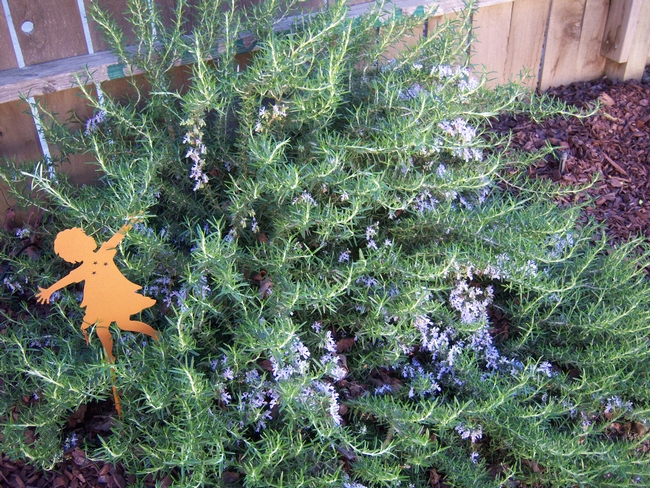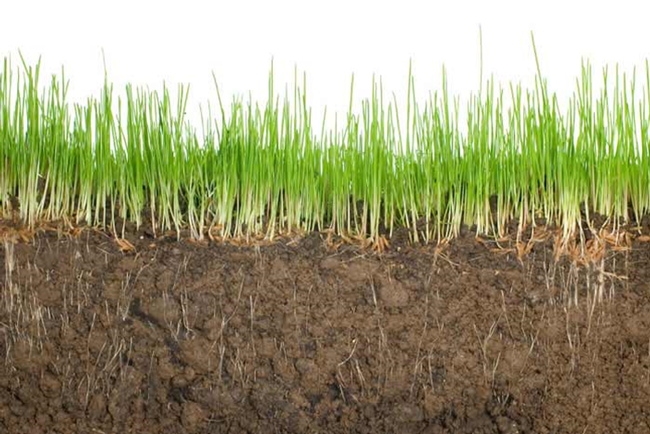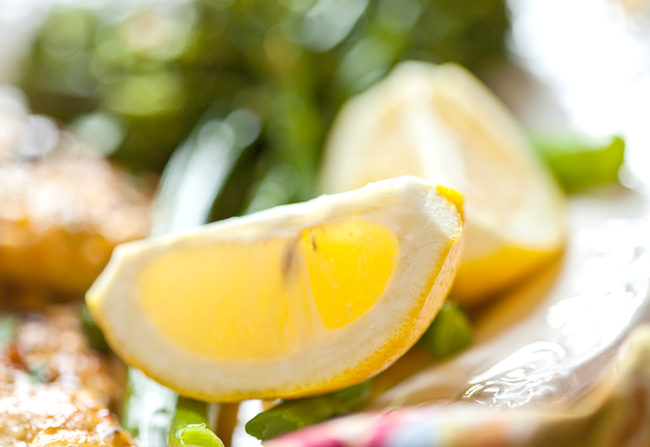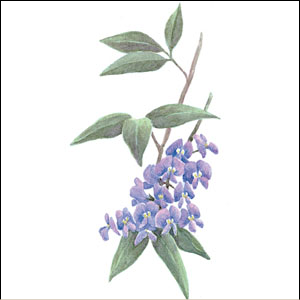- Author: Gerry L Hernandez
Perennial vegetables and herbs for your garden
Personally, I am not a big vegetable gardener. I actually have a hard time growing zucchini. Now, don't laugh at me! If you are like me and love perennial plants then here is a list of great plants for you. All of these can be “inserted” into your landscape and look beautiful.
Perennial Vegetables
- Artichokes - Light afternoon shade in our hot valley. When I was growing up artichokes lined our driveway. I have artichokes in my garden now. Gophers can be a problem.
- Asparagus - The plants are tall, feathery and graceful. You will not get a lot of asparagus but the plant is beautiful!
- Cardoon - Similar to artichokes but grown for the edible stalks. This is also great in the landscape.

- Rhubarb - Needs partial shade in the valley. Great showy foliage for the garden.
Perennial Herbs
- Chives - Snip the leaves to use in the kitchen. Beautiful leaves and flowers. Great border plant.
- Lavender - Beautiful and very fragrant. Attracts bees to the garden. I have lavender in my garden and love it.
- Lemongrass - It will grow to about 3 feet wide and 3 feet tall. It looks like a tall clump of grass. Cut off the stem just above the crown and use in recipes. Yes, I have this in my yard and it is beautiful.
- Marjoram - 1-2 feet tall, great filler plant or ground cover for your landscape. Snip off a few leaves for cooking.
- Mint - Plants easily spread. Once you have mint you have mint forever. It is very fragrant.
- Oregano - Low growing ground cover plant. I have this one in a container and it produces a carpet of beautiful flowers.
- Rosemary - Who doesn't have rosemary in their garden? Great foundation plant, beautiful flowers and easy touse in recipes. Yes, I have a beautiful rosemary plant in my yard.

- Sage - Needs afternoon shade. Great gray color for the garden. I have sage and it can get a little scraggly, just keep it trimmed back.
- Sweet Bay - Can be a tree or shrub. Grows to 12 – 20 feet tall. Beautiful flowers. We had a bay tree growing up. Snip a leaf and throw in a soup.
- Tarragon - Needs light shade. French tarragon has rhizomes. It is best in a container.
- Thyme - Small plant with heavily scented leaves. Great in a rock garden.
Our next post will be about berries, vines and fruit trees.
- Author: Gerry L Hernandez
Nurture the Soil
1. Grasscycling
A. Did you know that grass clippings have 4% nitrogen. By putting the clippings back into the lawn you are using less fertilizer.
2. Mulch Regularly
A. Mulch is any material spread over the soil. It can be leaf litter, bark or rocks
B. You need 2-4 inches at all times to suppress weeds
3. Feed Soils Naturally
A. Add a thin layer of compost to your soil
B. Feed turf by topdressing with compost instead of commercial fertilizer
C. Apply compost 2-4 times a year to your plants instead of commercial fertilizer
4. Minimize the use of Chemical Pesticides
A. Many pesticides are toxic to microbes and other soil dwelling creatures, worms are great workers and we need to keep them alive
B. If pesticides are needed chose the least toxic first. Always read the label
C. Learn IPM www.ipm.ucdavis.edu
Benefit:
Conserve water
Enhance plant growth
Suppress weeds
Improve the appearance of your garden
- Author: Gerry L Hernandez
Artichokes
To me, artichokes look like they are out of the Dinosaur era. They are a big, course, fern-looking plant. The plant is a beautiful silver grey color and will fit into any landscape. Yes, you can mix artichokes in with your flower beds. Just keep in mind they need sun.
In the Sacramento Valley:
- Needs sun but some afternoon shade is good.
- Can be purchased at a Garden Center in the spring as “bareroot”.
- They are water-wise and only need a need to watered thoroughly once a week.
- Perennial plant in the Sacramento Valley.
- The buds are what we eat.
- If you don't want to eat them, let them continue into a thistle-like flower.
- This plant is so versatile.
- It's beautiful as a landscape plant
- It has edible buds.
- The flower is commonly used in floral arrangements.
- Author: Gerry L Hernandez
Baked Lemon Chicken with Mushroom Sauce
Quick and easy dinner for 6. Serve over rice or noodles and add a salad or vegetables side dish.
Ingredients:
6 skinless, boneless chicken breast halves
Salt and pepper
1 T. olive oil
1 lemon
¼ cup butter or margarine
3 cups fresh sliced mushrooms
½ cup chicken broth
2 T. all-purpose flour
1 T. chopped fresh parsley
Directions:
Preheat oven to 400 degrees.
Lightly salt and pepper the 6 chicken breasts. Place the chicken in an 8x8 or 9x13 baking dish that has been coated with the 1 tablespoon of olive oil. Squeeze the juice of ½ lemon all over. Slice the rest of the lemon and place one lemon slice on top of each piece. Bake in the preheated oven for 30 to 40 min. to cook through and brown.
In a large skillet, melt the ¼ cup butter or margarine. Add the sliced mushrooms and cook until they are brown and have exuded their juices, about 6 minutes. Sprinkle with the flour and blend. Add the chicken broth, stirring to make a creamy sauce. Add fresh parsley at the last minute. Spoon the sauce over the lemon baked chicken breasts. This is a versatile dish that you can bake or brown in a skillet and then cover to complete cooking time.
This would be a great Valentine's dinner!
Welcome to the days of Hardenbergia comptoniana
Here we are at the end of January and outside our south facing windows waits my gorgeous Hardenbergia - Hardenbergia comptoniana, an Australian native was named for Franziska, Countess von Hardenberg, sister of Baron Carl AA von Hugel, a 19th century Australian patron of botany. H. comptoniana belongs to the Papilionaceae family. According to Botanary, this family name is from the Latin papilio (butterfly), after the shape of the pea and bean flowers.
When most of the rest of the yard is still sleeping this amazing plant starts a 4-5 week show of sweet pea shaped flowers on vines that will grow to the size you want them to be. If it gets too rambunctious just whack it back. Mine gets full sun in the spring and then doesn't mind a bit of afternoon shade later in the summer. We also planted them on the fence at the PG&E substation on Market Street here in Colusa. They are thriving and will move along the fence to mask the industrial yard behind it.
It is also known as coral pea, native lilac vine, wild sarsaparilla and wild wisteria and has a twining vine that can take off if you aren't paying attention but responds to the pruning shears quite well. It received regular water while young and now has very low moisture requirement after about six years. Once it is established, it can take quite a bit of dry weather if grown in light shade. Feed a well balanced fertilizer every two to three months.
Pruning can be done after blooms fade. For a thicker vine, prune the vine only where it twines around itself. It is important to note that this vine will scramble across the ground and wrap itself around other plants. Keep a watchful eye out for this tendency.
There are cultivars which have more shrub-like growth habits such as the H. violacea ‘Mini Haha'. Blooms appear from winter through spring in a variety of colors including white, pink and various shades of purple.
Plant one in an area that needs some early color and just enjoy the evergreen beauty of this “hardy” bergia!!







